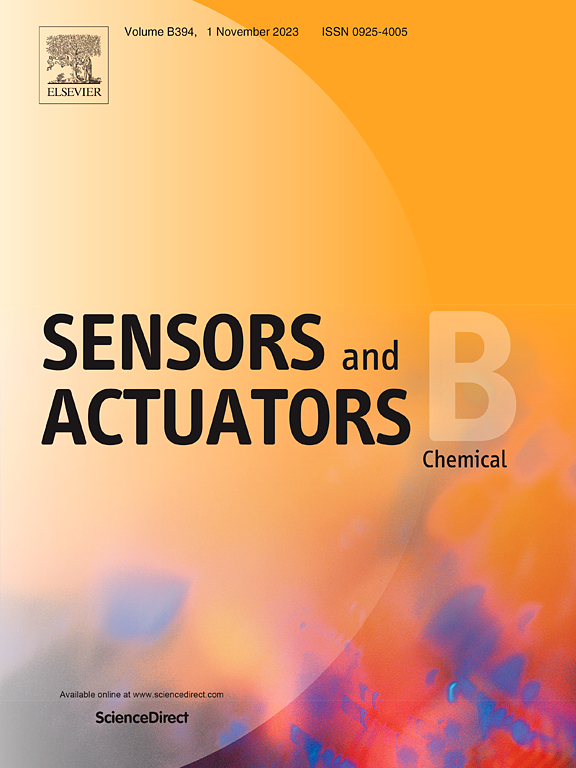Battery-free wearable sensors with ion-selective electrodes embedded in passive resonant antenna circuits for wireless sweat monitoring
IF 3.7
1区 化学
Q1 CHEMISTRY, ANALYTICAL
引用次数: 0
Abstract
Compositional analysis of sweat as a liquid biopsy offers significant potential for advancing personal healthcare. Wireless and wearable technologies enable continuous, effortless monitoring of sweat during daily activities. However, conventional potentiometric methods face limitations due to complex wiring and bulky devices, making them unsuitable for wearable applications. Additionally, signals from traditional methods, such as potential changes or resonant antenna power spectra, are often unstable due to sensor placement and environmental variations. To address these challenges, we developed a battery-free wireless ion-sensing system combining ion-selective electrodes and varactor diodes within a resonant antenna circuit. This system converts interfacial potential changes, triggered by variations in sweat ion concentrations, into capacitance changes, which are detected as shifts in resonant frequency. The system demonstrated Nernstian linear responses for Cl−, Na+, and K+ ions across concentrations of 10−4 to 1 M, comparable to conventional potentiometric methods. Notably, resonant frequency-based detection maintained stable performance regardless of the distance or angle between the sensor and reader coil, thereby ensuring practicality for wearable applications. By integrating the resonant antenna circuit onto a flexible polydimethylsiloxane substrate, the system achieved selective detection of Cl− and Na+ ions within physiological ranges in artificial sweat containing interfering ions. Combining stability, selectivity, and a battery-free design, this system provides a robust platform for real-time sweat ion monitoring, paving the way for practical, seamless health management in daily life.

无源谐振天线电路中嵌入离子选择电极的无电池可穿戴传感器,用于无线汗液监测
作为液体活检的汗液成分分析为推进个人医疗保健提供了巨大的潜力。无线和可穿戴技术可以在日常活动中连续、轻松地监测汗水。然而,由于复杂的布线和笨重的设备,传统的电位测量方法面临局限性,使其不适合可穿戴应用。此外,传统方法的信号,如电位变化或谐振天线功率谱,由于传感器的放置和环境的变化,往往是不稳定的。为了解决这些挑战,我们开发了一种无电池无线离子传感系统,该系统将离子选择电极和变容二极管结合在谐振天线电路中。该系统将由汗液离子浓度变化引发的界面电位变化转化为电容变化,从而通过谐振频率的变化检测到电容变化。该系统对Cl−、Na+和K+离子在10−4至1 M浓度范围内的线性响应与传统电位法相当。值得注意的是,基于谐振频率的检测无论传感器与读取器线圈之间的距离或角度如何,都能保持稳定的性能,从而确保了可穿戴应用的实用性。通过将谐振天线电路集成到柔性聚二甲基硅氧烷衬底上,该系统实现了对含有干扰离子的人工汗液中生理范围内Cl -和Na+离子的选择性检测。结合稳定性、选择性和无电池设计,该系统为实时汗液离子监测提供了一个强大的平台,为日常生活中实用、无缝的健康管理铺平了道路。
本文章由计算机程序翻译,如有差异,请以英文原文为准。
求助全文
约1分钟内获得全文
求助全文
来源期刊

Sensors and Actuators B: Chemical
工程技术-电化学
CiteScore
14.60
自引率
11.90%
发文量
1776
审稿时长
3.2 months
期刊介绍:
Sensors & Actuators, B: Chemical is an international journal focused on the research and development of chemical transducers. It covers chemical sensors and biosensors, chemical actuators, and analytical microsystems. The journal is interdisciplinary, aiming to publish original works showcasing substantial advancements beyond the current state of the art in these fields, with practical applicability to solving meaningful analytical problems. Review articles are accepted by invitation from an Editor of the journal.
 求助内容:
求助内容: 应助结果提醒方式:
应助结果提醒方式:


